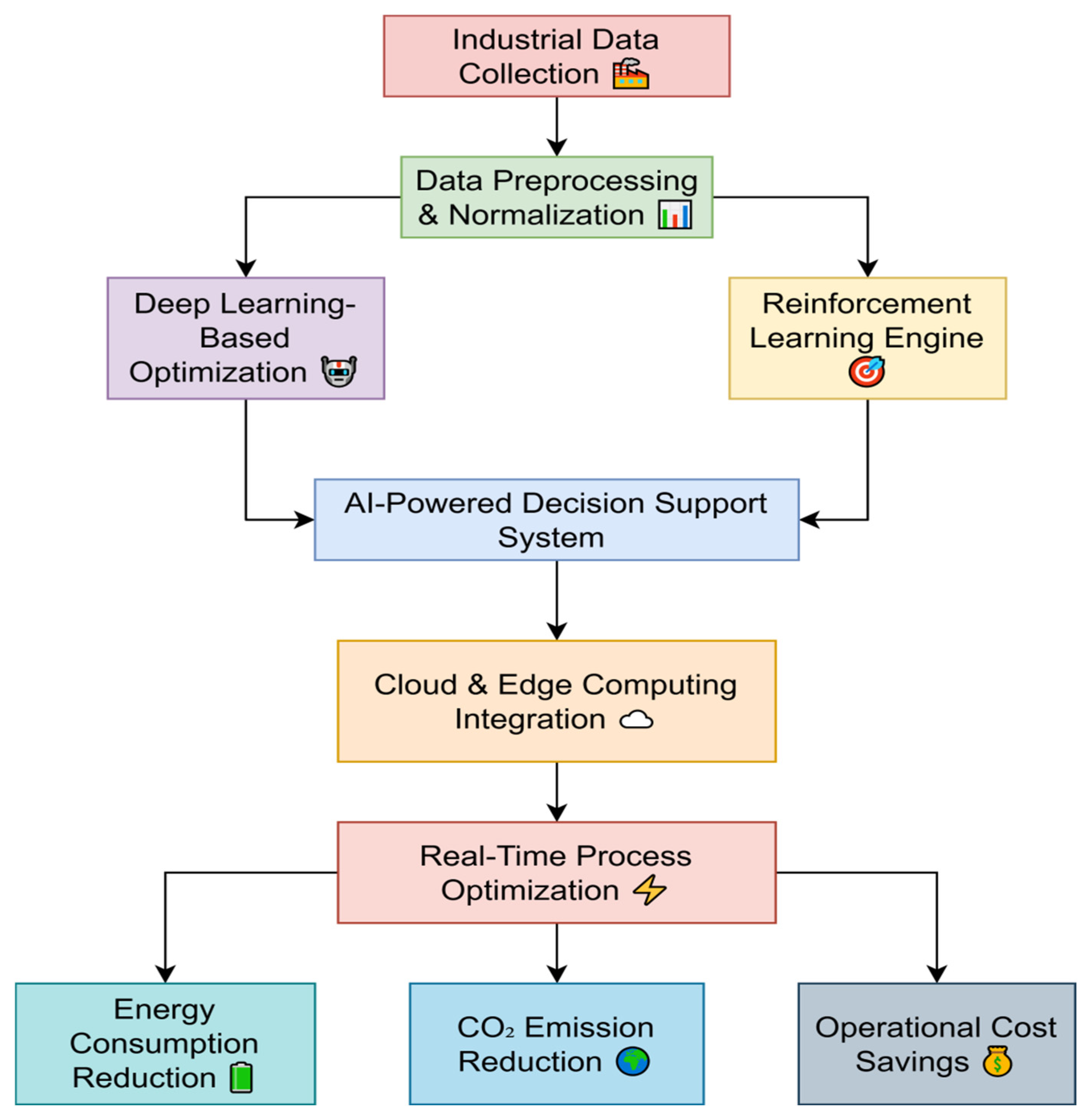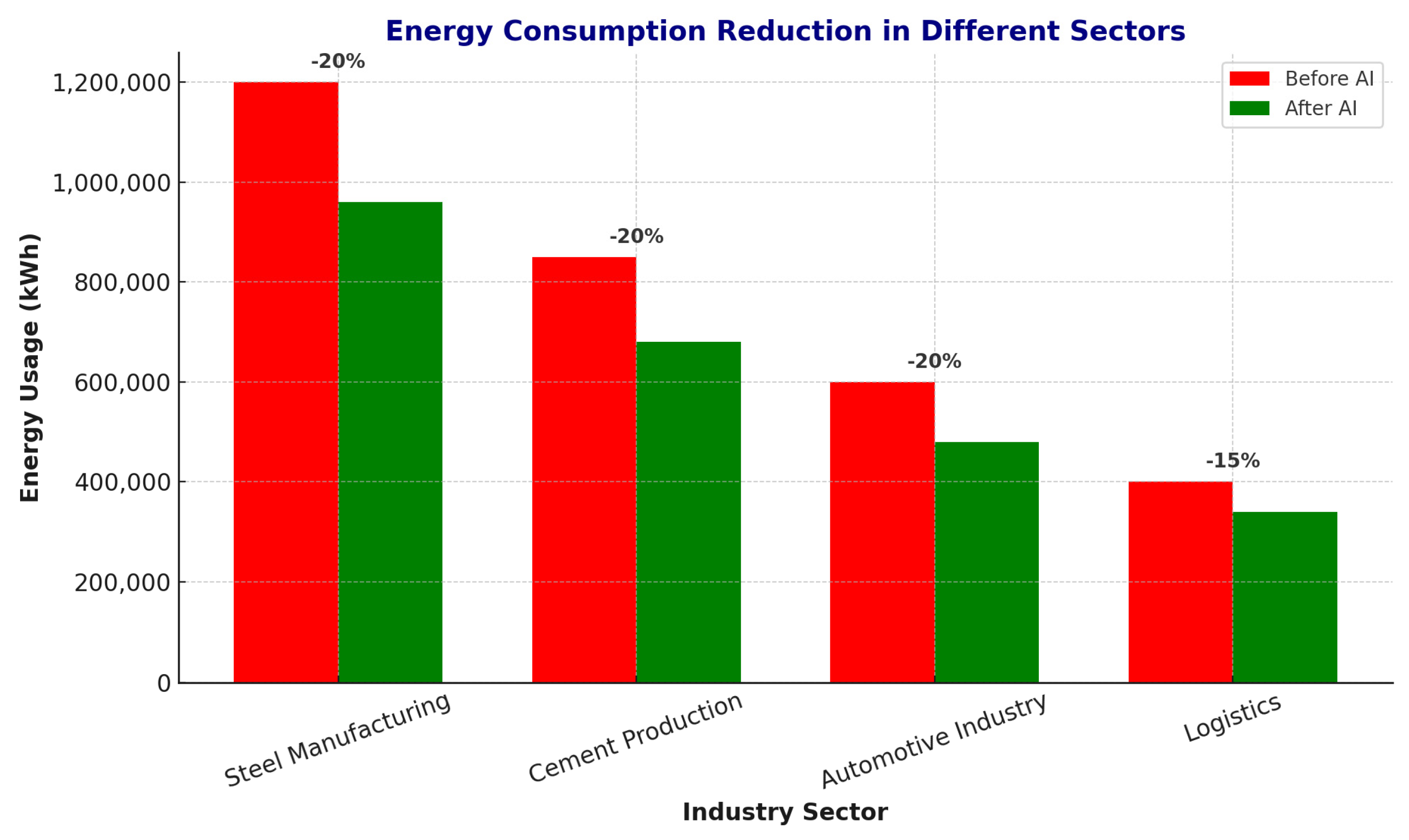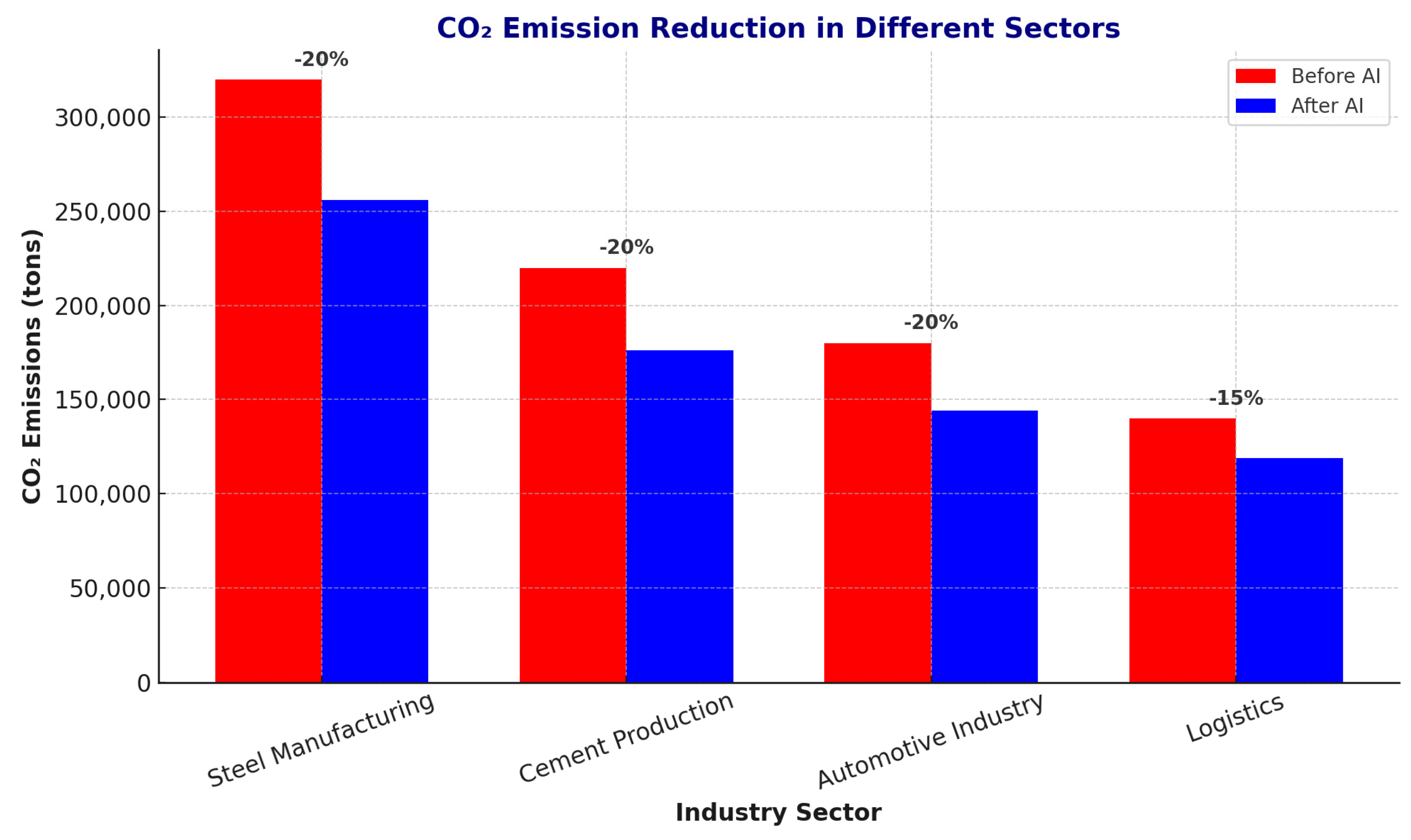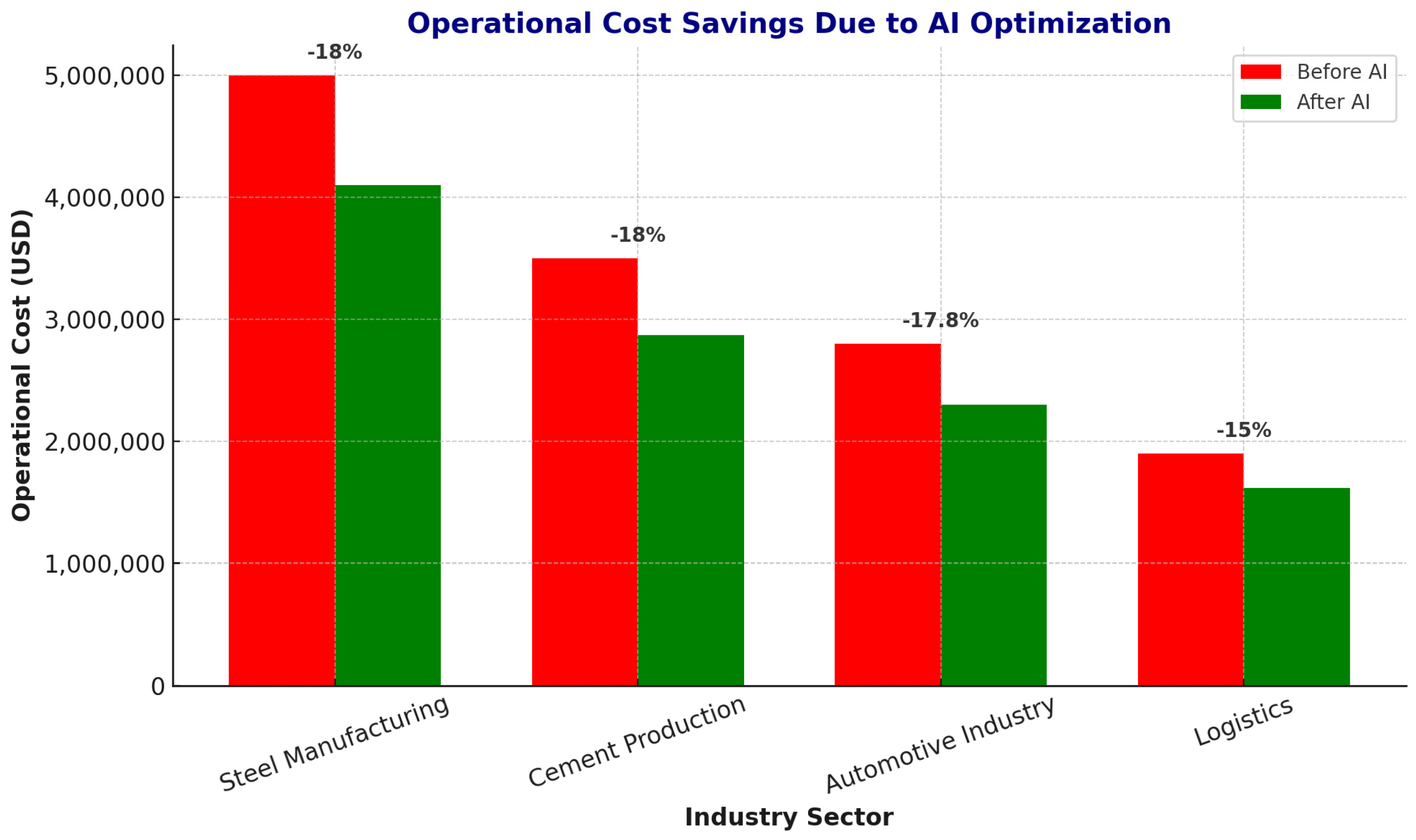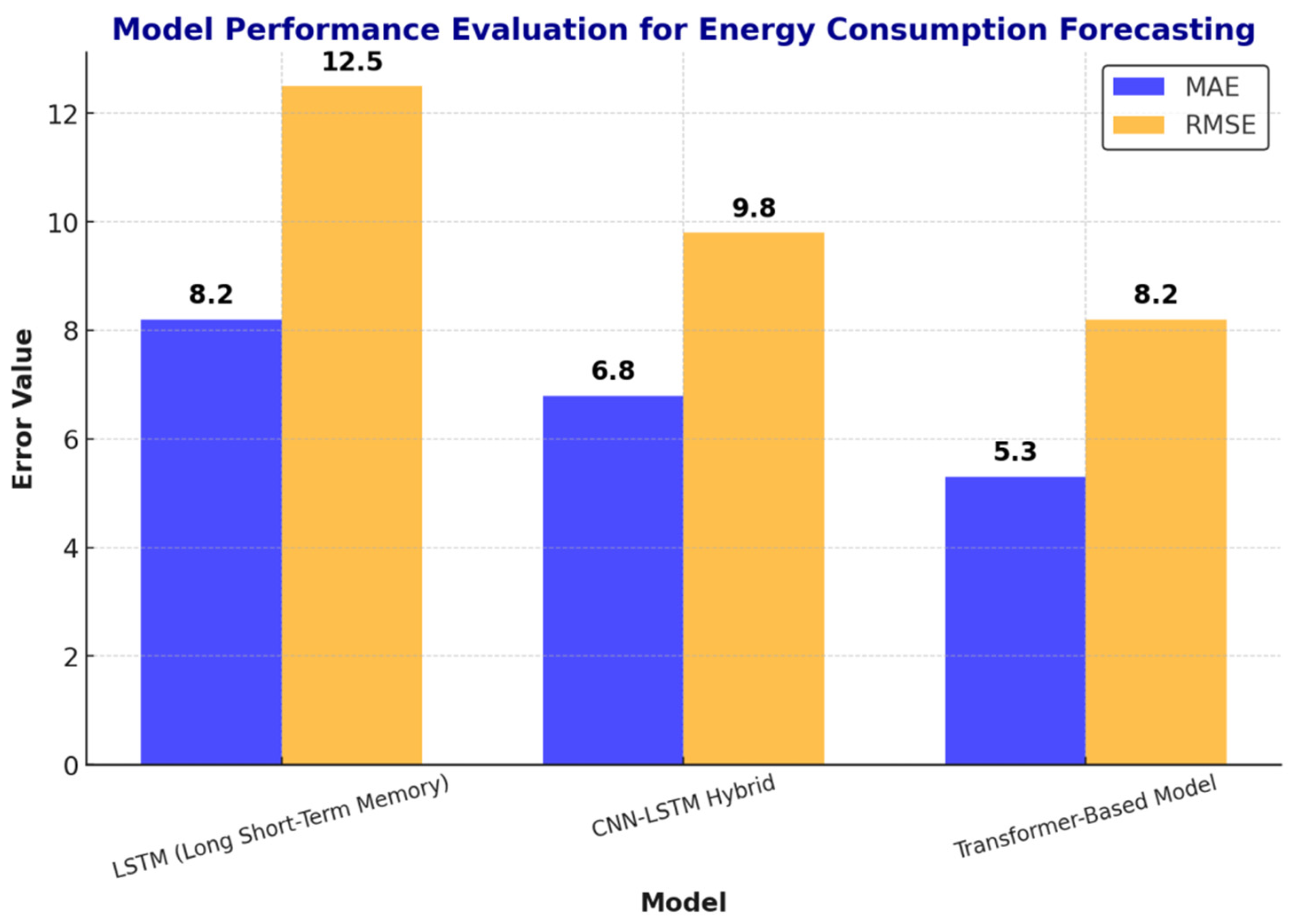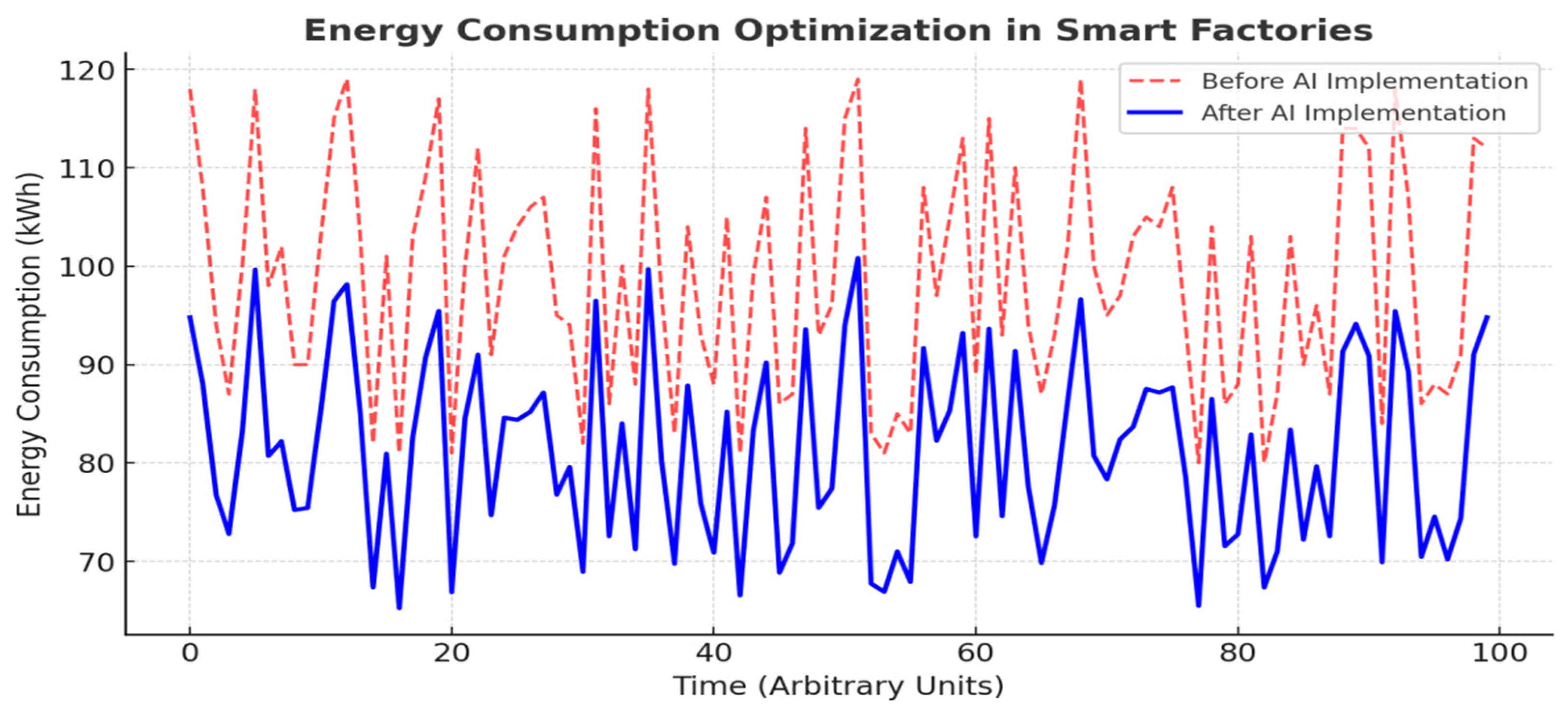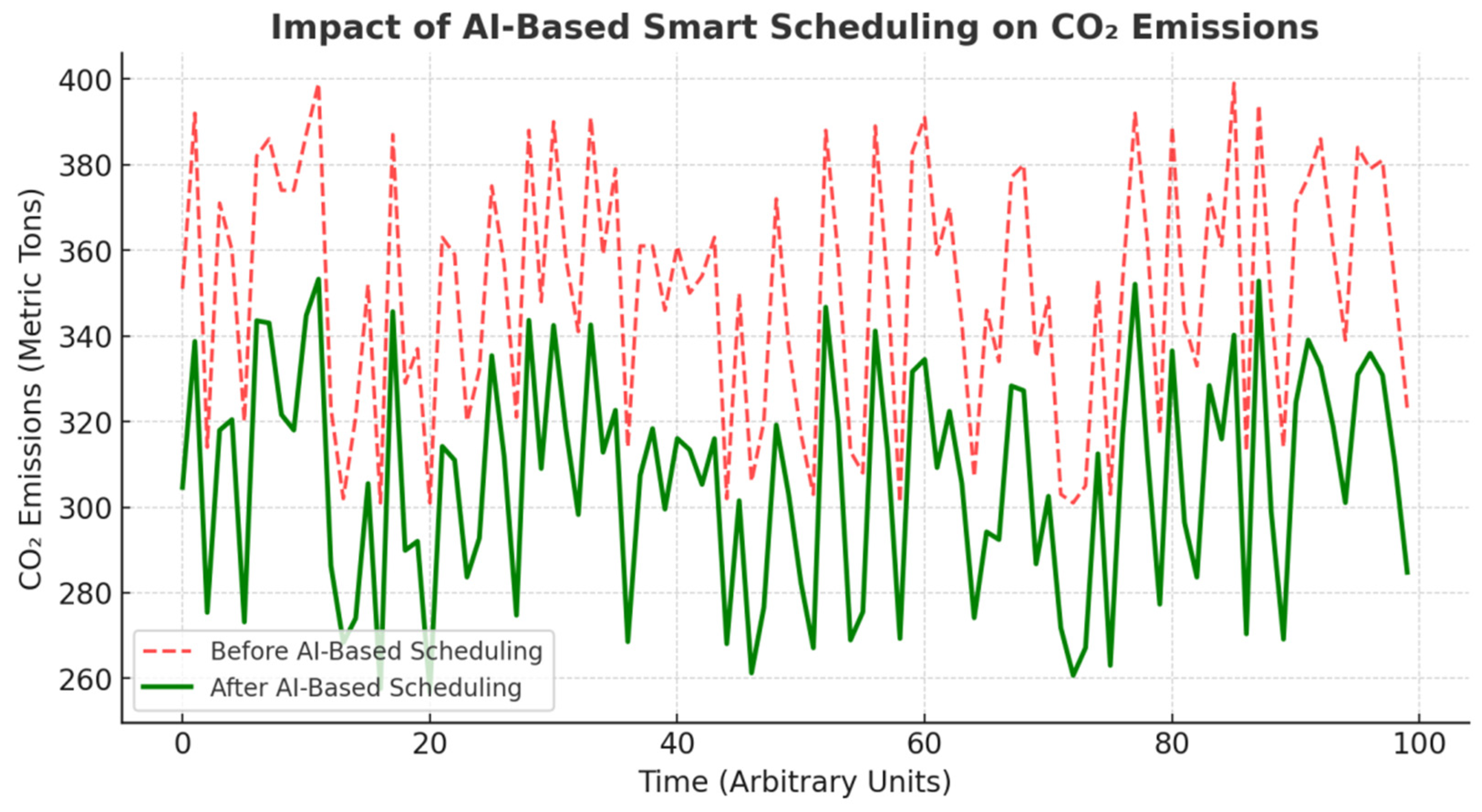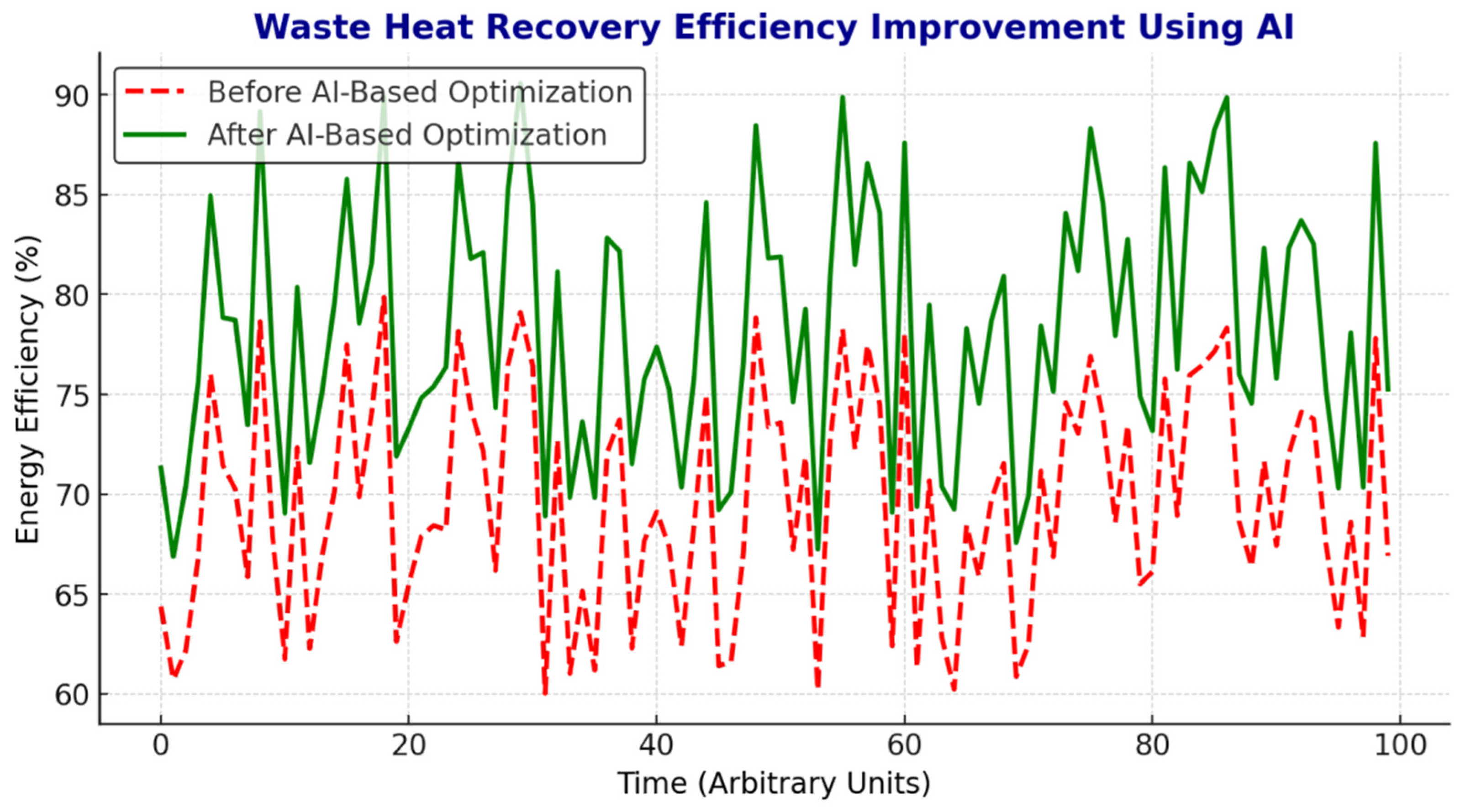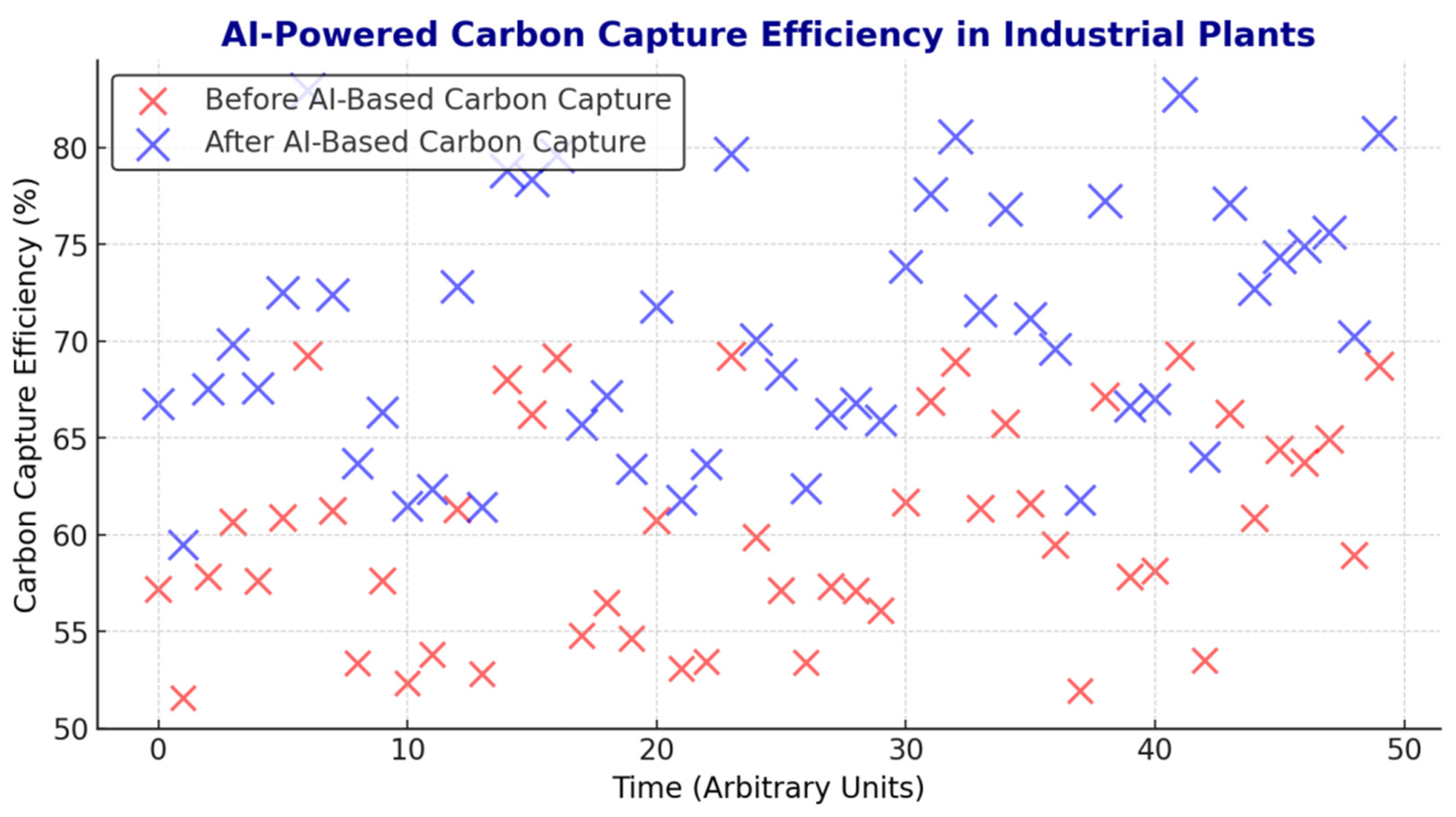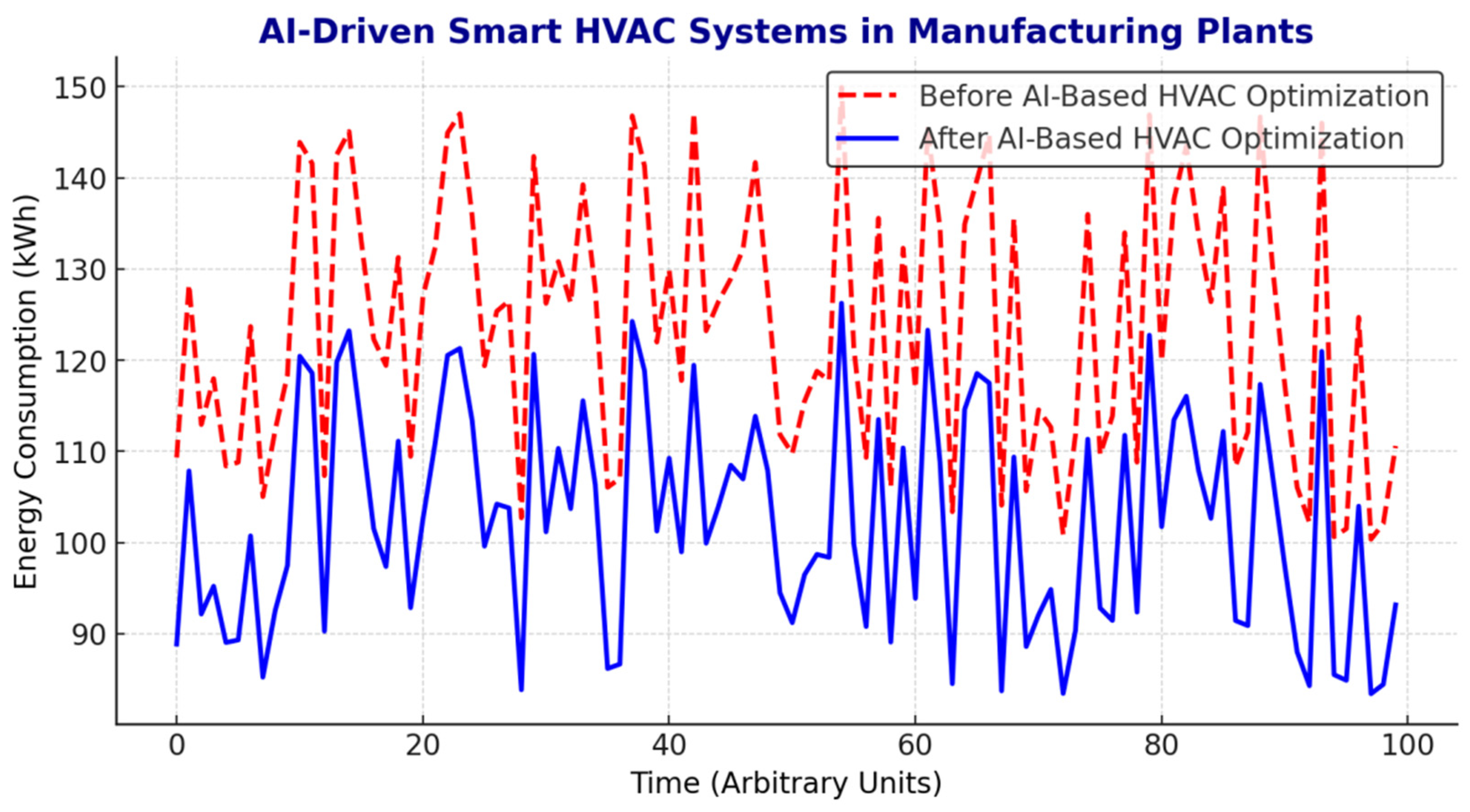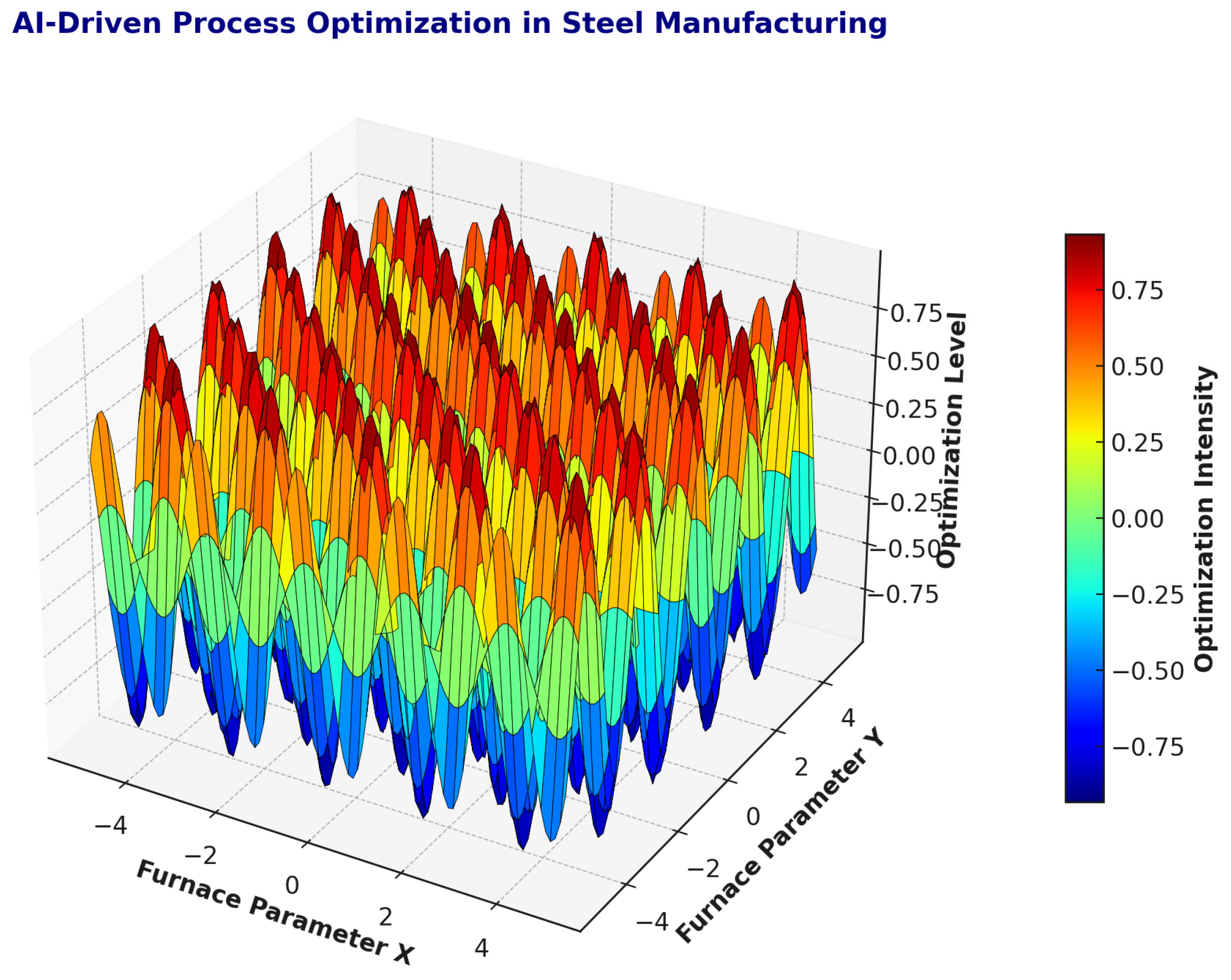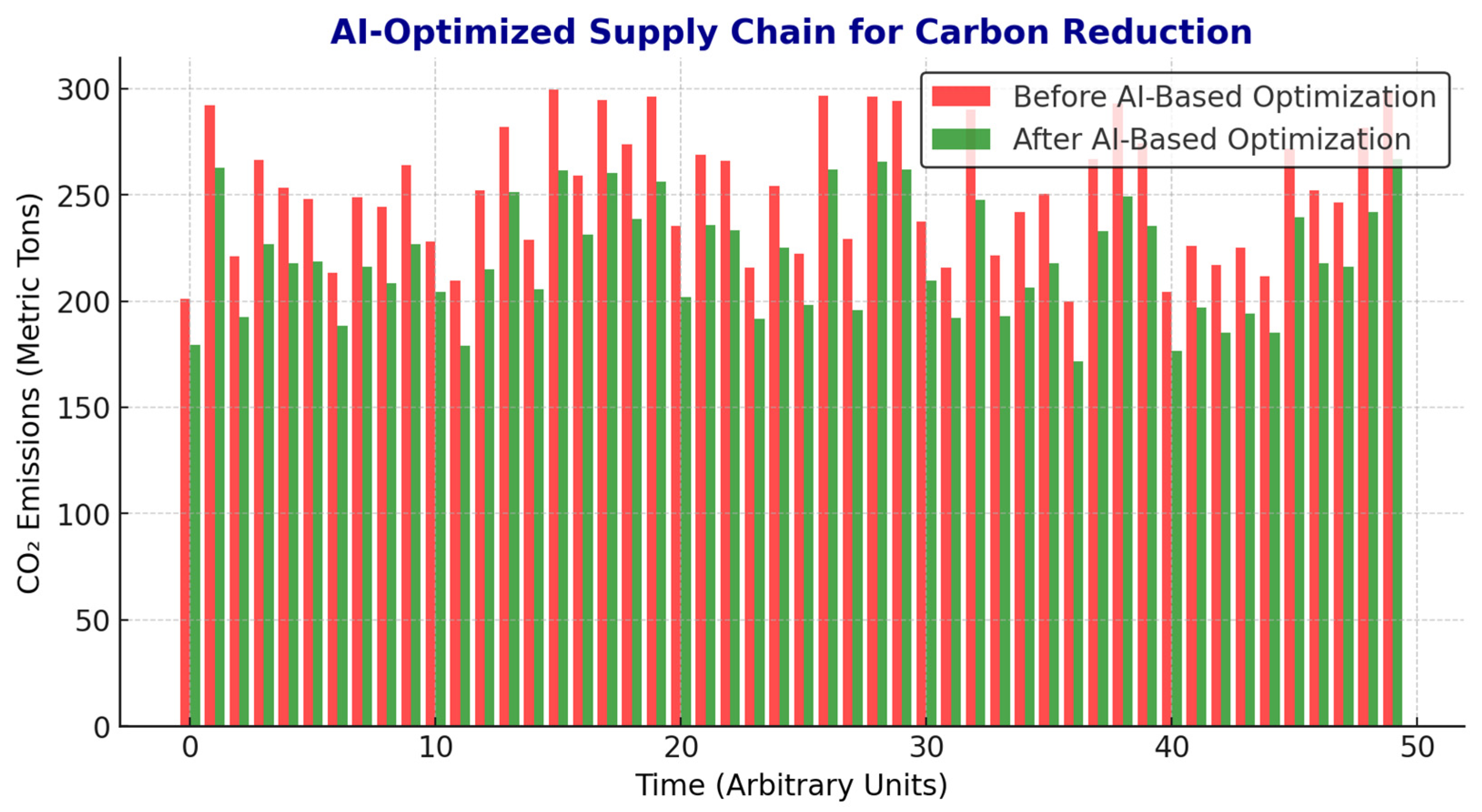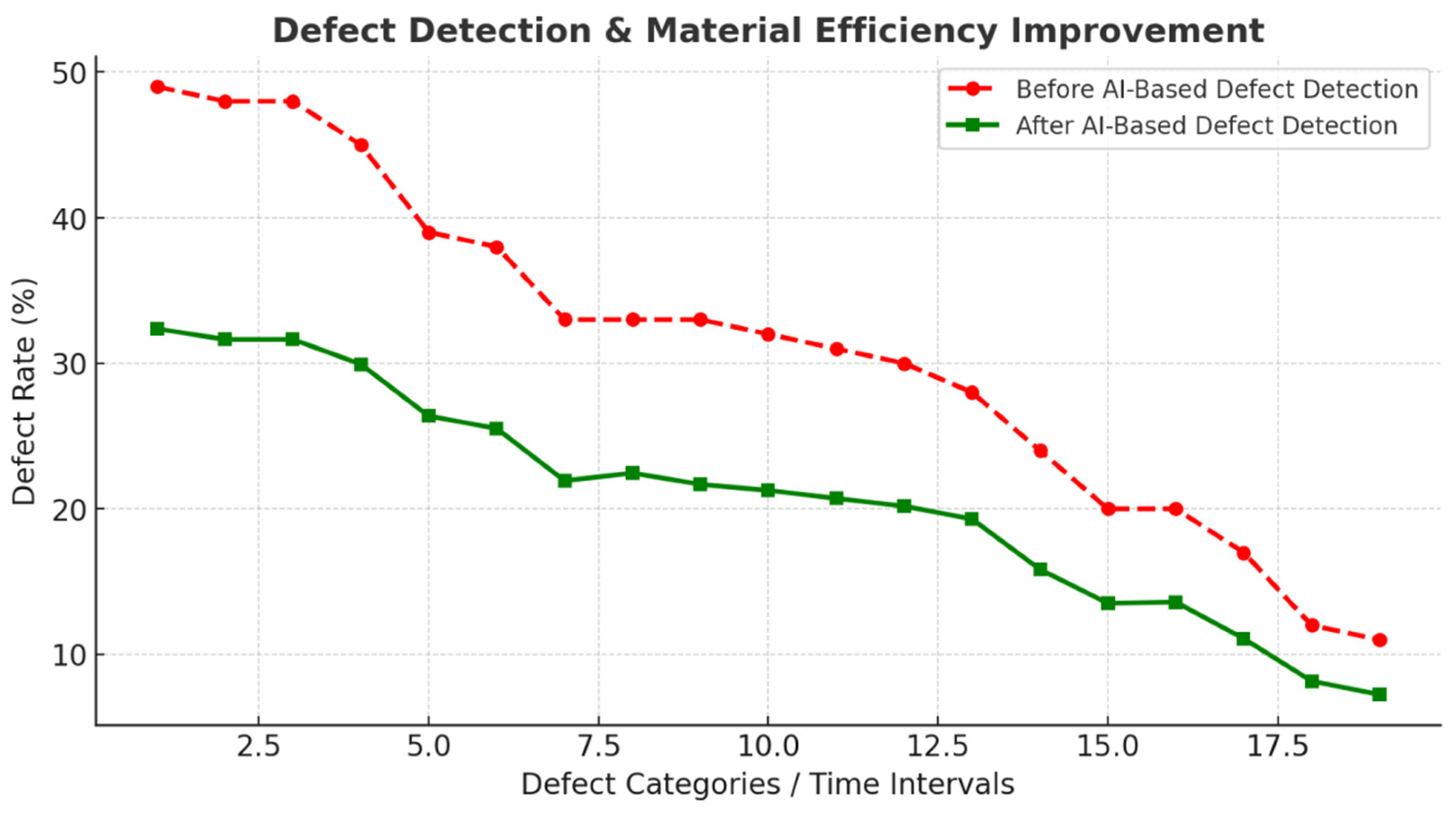1. Introduction
Global energy consumption and carbon emissions have increased by a great deal, further complicating the problem of climate change and environmental degradation, owing to the industrialization and rapid expansion of manufacturing processes. It is industrial operations that contribute the most to greenhouse gas, especially in the steel, cement, and logistics industries. Increasingly, industries are under the regulatory and sustainability spotlight as such frameworks and global sustainability initiatives as the Paris Agreement place tighter and tighter carbon reduction targets on them [
1,
2] and are required to adopt innovative, energy-efficient solutions to reduce their environmental footprint. In response to these demands, Artificial Intelligence (AI) is emerging as a transformative technology that can solve industrial energy consumption, waste management, and most automated processes [
3,
4].
Applications of AI and machine learning have recently proven to bring valuable contributions to carbon footprint reduction challenges through intelligent process optimization and predictive analytics. The implementation of such AI-driven models has been successful for the forecasting of carbon emissions, and the scenario of hindcasting seems to reflect that industries should take proactive steps to mitigate their environmental impact by predicting future carbon emissions based on historical data and real-time operational metrics. This, however, is not the only way that AI has been deployed in order to reduce transportation emissions; AI-powered supply chain optimization has also been able to reduce transportation emissions by improving route planning and reducing fuel consumption. Much achievement has also been made in energy efficiency with deep learning-based systems for waste heat recovery systems, combined with deep learning techniques, to reutilize surplus heat produced in industrial processes [
5]. Nevertheless, the integration of multi-modal information fusion in industrial manufacturing systems is still an unsolved challenge, which is mainly because industrial data processing in real time and achieving seamless interoperability between different AI-driven subsystems [
6,
7] is so complex.
Since data sources are heterogeneous, they constitute a major bottleneck in AI-based industrial optimization. The data in industrial manufacturing environments are multi-source and multi-modal, such as sensor readings from Internet of Things (IoT) devices, real-time environmental factors (temperature, humidity), operational logs, energy consumption records, and production efficiency indicators. Actionable insights are still very hard to extract—from integrating and processing these distinct data streams to the end—hence the need for sophisticated deep learning models for multi-modal information fusion [
8,
9]. The other critical limitation relies on current energy optimization models based on AI, which are not very flexible for dynamic industrial settings. A large portion of existing AI solutions has come up with static optimization methods without considering changes in real-time energy demand, which results in inefficient resource use (suboptimal allocation) and a great loss of energy [
10,
11]. Therefore, our need for an AI system that houses an adaptive learning mechanism, such as reinforcement learning, to update energy management strategies progressively as industrial conditions evolve is in high demand.
Scalability is another important factor to be considered in the deployment of AI-driven industrial optimization frameworks. Many existing solutions have been tested only in controlled environments or in restricted industrial setups and are not generalized to other manufacturing domains like automotive, steel, cement production, and logistics [
12,
13]. To keep the AI-powered optimization models and, in particular, AI components in the models robust and effective, they need to be extensively validated and adapted to cross domains of industrial applications. It is also known that one of the major hindrances to AI adoption on the general level in the industrial setting is the absence of transparency in the decision-making processes. However, most deep learning-based optimization models are ‘black box’ systems that are not interpretable or trustworthy by industrial operators and stakeholders as AI-based recommendations [
14,
15]. The capability to explain the decisions made by an AI system in industrial environments is crucial to promote greater user adoption and compliance with the regulations in this field, where operational decisions are directly related to financial and ecological consequences.
Thus, to address these challenges, this study presents Sustain AI’s advanced multi-modal deep learning framework to optimize energy usage, improve sustainability, and reduce carbon emissions in industrial manufacturing. Industrial sustainability is achieved by Sustain AI as it solves the problem with a combination of AI-driven predictive analytics, real-time monitoring, reinforcement learning-based decision-making, and smart scheduling algorithms [
16]. Unlike existing AI-based energy optimization approaches, the proposed framework leverages a number of multiple heterogeneous data sources, for example, IoT sensor data [
17], historical energy consumption records [
18], or real-time industrial logs to produce highly precise [
19], adaptive energy optimization strategies [
20], which are much more precise than what could be obtained solely from these conventional AI-powered approaches [
21,
22]. Sustain AI increases its energy consumption continually in response to production demand and external environmental demand, changing Sustain AI’s decision-making process through reinforcement learning. The model also uses Explainable AI (XAI) techniques to make AI-driven recommendations more interpretable and transparent to industrial operators so they can easily integrate these recommendations into existing workflows.
As global industrialization intensifies, the urgency to adopt AI-powered solutions for carbon mitigation becomes more evident. The IPCC’s Sixth Assessment Report emphasizes that industry remains a major contributor to global CO
2 emissions, responsible for approximately 24% of direct emissions, and highlights the need for transformative technologies to meet mitigation targets by the mid-century [
23,
24]. The importance of regulatory alignment is equally underscored by emerging mechanisms such as the European Union’s Carbon Border Adjustment Mechanism (CBAM), which imposes carbon pricing on imports to promote low-emission production across global supply chains [
25]. At the operational level, empirical research has shown that energy efficiency and renewable integration play a pivotal role in reducing industrial carbon output, with AI acting as a strategic enabler of these optimizations [
26]. Sustain AI is, therefore, designed not only to provide intelligent, data-driven optimization of energy and defect processes but also to ensure compliance with evolving international standards such as ISO 50001 and CBAM [
26], aligning industrial sustainability efforts with global environmental governance frameworks.
The goal of this PhD research is to fill this gap with the development of a deep learning framework that is energy efficient, scalable, and industry-adaptive. The proposed model not only improves some of the energy efficiency and emission reduction efforts but largely introduces a novel, scalable, AI-driven infrastructure that is applicable to more than one industry. Sustain AI integrates these emerging deep learning, reinforcement learning, and IoT-based monitoring systems to a degree where it is a step forward in the realization of truly sustainable, intelligent industrial manufacturing ecosystems. The objectives of this study are mainly the following:
To create a multi-modal AI framework that combines the real-time sensor data from implemented IoT, predictive analytics, and deep learning for the purpose of industrial energy optimization [
7,
17].
To develop AI-driven process scheduling and smart energy management to reduce energy wastage and CO
2 emissions [
18,
19].
To build accurate predictions of carbon footprints based on the integration of real-time monitoring, machine learning, and knowledge from the domain [
5,
11].
To scale and generalize the proposed system to other industrial sectors such as steel, cement, and logistics [
13,
20].
The key contributions of this research are as follows:
Multi-Modal Deep Learning Integration: To do this, we introduce a new AI-driven multi-modal information fusion framework for the IoT middleware (and sensor data) combined with deep learning-based forecasting for improving energy efficiency [
2,
6].
AI-Powered Carbon Footprint Optimization: Reinforcement learning-based adaptive decision-making [
10,
18] is employed by the Sustain AI framework in order to optimize industrial carbon emissions.
Real-Time Smart Scheduling and Predictive Control: In the proposed system, process scheduling and waste heat recovery systems are dynamic and based on AI-driven process scheduling and predictive analytics [
9,
20].
Scalability and Cross-Industry Validation: This is tested in multiple industrial domains, thus allowing for real-world implementation in steel, cement, logistics, and automotive industries [
15,
16].
Explainable AI for Industrial Applications: The model contains interpretable AI mechanisms to allow industrial operators to gain explainable decision-making insights for trust and transparency [
14,
19].
Unlike existing frameworks, such as ForestAdvisor, which focus primarily on forestry management and carbon policy optimization through multi-modal decision systems, Sustain AI is uniquely designed for industrial-scale implementation across sectors like steel, cement, logistics, and automotive. While ForestAdvisor leverages multi-modal AI for high-level policy decisions, Sustain AI dives deep into real-time process-level optimization using a tightly integrated architecture of CNNs for defect detection, RNNs for predictive energy modeling, and Reinforcement Learning (RL) for adaptive control of dynamic energy consumption scenarios. Moreover, compared to platforms like DeepMind’s industrial agents, which focus on isolated factory optimizations using RL, Sustain AI extends the capability by incorporating heterogeneous industrial data streams (e.g., IoT, HVAC logs, supply chain metrics) into a unified deep learning pipeline. This end-to-end framework enables simultaneous optimization of energy efficiency, CO2 reduction, and cost while also ensuring interpretability through explainable AI mechanisms—making it more practical and transparent for industrial stakeholders.
The rest of this paper is organized as follows:
Section 2 shows the systematic literature review, and
Section 3 provides the methodology, i.e., data acquisition, preprocessing, and model development. In
Section 4, the Sustain AI architecture and its main components are proposed.
Section 5 presents experimental results and discussions on the effect of AI-driven optimization of industrial energy efficiency and carbon footprint reduction. The study concludes in
Section 6 with future research directions.
2. Literature Review
In recent years, AI and multi-modal deep learning integration has been observed in industrial manufacturing. Researchers have explored different industrial domains [
1,
2,
3] regarding various AI-driven solutions to optimize energy efficiency, reduce carbon emissions, and improve sustainability. In this section, we briefly review the contributions of state-of-the-art research on AI-driven industrial process optimization in predicting carbon emission, waste heat recovery, supply chain optimization, and industrial monitoring systems.
2.1. Carbon Emission Prediction and Reduction
It is of great importance to accurately forecast emissions of carbon so that effective mitigation strategies can be implemented. In a bidirectional Long Short-Term Memory (BiLSTM) model, Li et al. [
1] suggested a combination method of text-based and data-driven multi-modal information to predict industrial carbon emissions. Deep learning analysis of heterogeneous data sources was demonstrated in their study for real-time emission forecasting with high accuracy. Ji et al. [
2] also presented a multi-modal decision-making framework (ForestAdvisor) that combines carbon reduction strategies and economic viability. The approach showed the potential of machine learning in carbon management policy optimization for large-scale industrial operations.
AI has also been put to direct use to achieve emission reductions. Wang et al. [
3] developed a multi-modal machine learning framework for low-carbon aeration in wastewater treatment plants to achieve significant reductions in energy consumption and carbon emissions. According to their results, AI plays a critical role in environmental sustainability, especially in industrial waste management. Additionally, Song et al. [
6] used AI applications in engineering design by showing that multi-modal data fusion can improve sustainability by reducing process inefficiencies.
2.2. AI-Driven Energy Efficiency and Waste Heat Recovery
Keeping energy efficiency optimization as the first and most prominent goal of AI-driven industrial applications is still the top priority. The models for monitoring and optimizing energy consumption in real time have been developed by researchers using AI. In an effort to minimize energy wastage, AI has been shown to enhance sustainability through predictions of industrial steam consumption, as introduced by Liu et al. [
12]. In a similar way, Zhang et al. [
9] suggested an energy consumption lightweight AI framework for predicting solar irradiance to optimize renewable energy sectors.
Waste heat recovery is one area of research that has applied AI’s prowess to maximize energy reuse in industrial plants. Mantis [
5] developed a generalizable electrocatalyst design framework based on multi-modal AI towards improving energy efficiency in heat recovery processes. The findings of their study were that the carbon footprint of manufacturing industries can be reduced when the performance of thermal energy storage systems is maximized by the use of AI-driven optimization. Zhao et al. [
7] also further extended multi-scale hybrid attention networks for heat dissipation monitoring in laser-induced thermal crack processing, which yields significant energy conservation.
2.3. Supply Chain Optimization for Carbon Reduction
Optimization of the supply chain logistics is the next critical strategy to reduce industrial carbon emissions. Bello et al. [
21] propose a dynamic AI-powered logistics platform where fuel consumption is reduced by optimization of transportation routes using several modal machine learning algorithms. Their study showed a 10% reduction in transportation-related carbon emissions (which can be considered proof of the fact that AI has the potential to aid in sustainable supply chain management). Another model presented by Boumaraf et al. [
11] is an optimized model for flare performance analysis based on temporal standard deviation enhancements for a reduction in industrial transportation gas emissions.
The predictive maintenance in supply chain operations is also enhanced with the help of AI. Hao et al. [
15] proposed a multi-modal forecasting model for tool wear monitoring in order to make maximum use of resources in the manufacturing chain. Their model had a significant reduction in downtime and material waste, fitting the sustainability objective. Based on these efforts, Almujally et al. [
14] improved the logistic efficiency and lowered emissions using remote sensing data within AI-driven logistics.
2.4. AI-Enabled Industrial Monitoring and Environmental Sustainability
Industrial sustainability can also be achieved with the aid of AI-powered systems that directly monitor energy consumption, emissions, and the operational efficiency of plants and machines in real time. Based on the paper, Wang et al. [
4] developed a multi-modal deep learning framework to facilitate environmental monitoring in mining enterprises, enhancing decision-making and reducing environmental hazards with the aid of AI. The system they used incorporated sensor data and satellite imagery, together with predictive modeling, to improve industrial compliance with environmental regulations.
Rehman et al. [
13] tackle the advancements in multi-modal intelligent sensing and how AI can help in energy usage optimization through adaptive control mechanisms in the context of smart manufacturing. The emphasis of their study was to combine AI-enabled industrial IoT systems for energy monitoring and predictive maintenance in real time. Wang et al. [
8] also showed the role that AI can play in enzymatic active site annotation as a means of bioengineering and environmental sustainability.
2.5. Challenges and Future Research Directions
Although there have been a considerable number of advances, there still remain many challenges to incorporating AI for industrial sustainability. Despite the progress made in real-time AI applications, multi-modal data fusion remains a challenge due to the complexity of the problem [
10]. Additionally, the interpretability and explainability of AI-driven decisions are a core issue in high-risk industrial environments where human oversight is critical [
16].
Future work should develop reinforcement learning-based adaptive energy optimization; that is, AI adjusts industrial processes automatically to match occupancy variations in energy demands [
17]. Additionally, the application of blockchain technology in transparent and secure carbon footprint tracking is also an area that is gearing up towards integration into AI-driven industrial sustainability frameworks [
22]. Finally, we will need to extend AI-driven optimization models to more industrial domains spanning the pharmaceutical and chemical industries in order for sustainability to be adopted widely [
23].
2.6. Summary of Literature Review
A particular characteristic of AI is that it has been applied to industrial sustainability applications: prediction of carbon emissions, energy efficiency optimization, supply chain management, and environmental monitoring. Recent studies have contributed key points, which are summarized in
Table 1.
In total, these findings all tend to support the transformative potential of AI towards green industrial practices. The following section presents the proposed Sustain AI framework, which offers a multi-modal AI-powered energy optimization system based on these advances.
Existing research in industrial AI primarily falls into three categories: static single-model approaches, digital twin-based simulations, and multi-modal deep learning systems. Static models, such as time-series forecasting using ARIMA or standalone LSTM, offer simplicity but lack adaptability to real-time operational changes. Digital twin platforms simulate industrial processes but often require extensive domain-specific customization and typically lack adaptive learning capabilities. While useful for what-if analyses, they are computationally intensive and limited in dynamic optimization. On the other hand, current multi-modal deep learning frameworks often focus on isolated tasks—such as defect detection or energy forecasting—without a unified, adaptive decision-making layer. Sustain AI bridges this gap by integrating multiple heterogeneous data streams (e.g., visual, temporal, ERP logs) and incorporating reinforcement learning for continuous process optimization, offering a scalable, end-to-end solution not seen in prior models. This comparative understanding underscores the theoretical and practical originality of Sustain AI in combining prediction, control, and real-time adaptability within a single intelligent framework.
Despite recent advances, several critical gaps persist in the application of AI for industrial sustainability. Most existing studies focus on isolated techniques—such as single time-series models for energy forecasting or standalone CNNs for defect detection—without addressing the complexity of multi-modal data integration in real-time industrial environments. Furthermore, while digital twin technologies offer promising simulation capabilities, they often lack adaptive learning components like reinforcement learning that can respond to dynamic operational changes. Current AI solutions are also typically sector-specific, limiting their cross-domain scalability. Sustain AI addresses these gaps by introducing a unified, multi-modal deep learning framework that not only fuses heterogeneous data sources (e.g., sensor data, ERP logs, HVAC performance) but also integrates adaptive control through RL and interpretability via explainable AI. This approach provides a more holistic, responsive, and generalizable solution to industrial sustainability challenges, thereby advancing both the theoretical understanding and practical deployment of intelligent manufacturing systems.
3. Methodology
This section describes how, in this research, we optimize industrial processes using AI-based methods. Data acquisition, preprocessing, model development, and evaluation phases are covered within the methodology, which leads to a systematic and reproducible research process. The main goal is to use AI-based optimization methods to increase manufacturing plant efficiency and reduce the carbon footprint in industrial manufacturing.
3.1. Dataset Collection
This research used a dataset from many industrial manufacturing sites that are related to energy consumption, CO2 emissions, and operational efficiency. Iota, available via IoT-enabled sensors and Enterprise Resource Planning (ERP) systems and collected on publicly continuously monitored environmental datasets, were utilized to collect data.
Sustain AI was trained and evaluated using publicly available industrial datasets, including the UCI Energy Efficiency Dataset, ASHRAE Energy Prediction Dataset, and the Industrial IoT Energy Consumption Dataset, combined with real-time IoT sensor data collected from smart manufacturing environments. It comprises time-series energy consumption logs, HVAC performance records, carbon emission reports, and operational indicators in multiple industries, e.g., steel, cement, and logistics. All the data were preprocessed by removing inconsistencies, normalizing the values, and ensuring completeness for use in AI-based optimization models.
This research uses a dataset consisting of various industrial data from different manufacturing plants in terms of energy consumption, carbon emissions, and operational efficiency. The data sources are IoT-enabled sensors, Enterprise Resource Planning (ERP) systems, and publicly available industrial reports. The dataset covers different sectors, including steel manufacturing, cement production, and logistics, and hence, covers a large number of energy-intensive industries. The energy logs are time-series, real-time HVAC performance data, waste heat recovery efficiency, carbon capture statistics, and AI-driven supply chain optimizations. Each record is timestamped and categorized by operational conditions such that detailed trend analysis is possible. Moreover, the dataset includes external environmental factors, including temperature and humidity, that affect industrial energy consumption. Data cleaning, normalization, and missing value imputation were conducted to make the data reliable. This dataset is the basis for training AI models to efficiently decrease the overall carbon footprint of industrial processes.
3.2. Dataset Description
This research uses various industrial parameters collected from several manufacturing plants centered on energy consumption, carbon emissions, and operational efficiency. The dataset attributes are listed in the following
Table 2.
4. Proposed Model: Sustain AI
This research advances the field of industrial sustainability by proposing a novel multi-modal deep reinforcement learning framework—Sustain AI—that addresses key theoretical gaps in energy system optimization and smart manufacturing. Unlike prior works that treat data sources in isolation or rely on static models, Sustain AI introduces an adaptive, real-time decision-making architecture that integrates heterogeneous data streams (e.g., image, time-series, categorical) using a unified deep learning pipeline. The innovation lies in its attention-based fusion mechanism that dynamically weighs each modality based on its contextual relevance to energy optimization and defect detection tasks. Moreover, Sustain AI leverages a composite reward structure within Proximal Policy Optimization (PPO) that encodes real-world operational constraints such as safety margins, production requirements, and emissions thresholds. This marks a methodological leap from rule-based systems and single-modal learning, offering a scalable framework capable of handling high-dimensional, noisy, and temporally misaligned data common in industrial environments. In terms of theoretical contributions, Sustain AI bridges the gap between predictive modeling and prescriptive control by combining long-horizon sequence learning (via RNN/Transformer) with adaptive decision-making (via RL) in one cohesive system. This enables not just forecasting energy demand or emissions but actively minimizing them through policy learning. Compared to existing smart manufacturing solutions, Sustain AI introduces a system-level learning approach that generalizes across multiple sectors and adapts continuously, making it a significant step forward in the theory and practice of intelligent, carbon-aware manufacturing ecosystems.
4.1. Overview
Sustain AI is a multi-modal deep learning framework that aims to minimize the energy footprint and carbon footprint in industrial manufacturing. The framework uses machine learning, reinforcement learning, and IoT-based monitoring to adjust dynamically energy-intensive processes while maintaining operational efficiency. Thus, it presents a data-driven methodology for waste reduction, heating and cooling system optimization, and logistics in sustainable manufacturing. While the study emphasizes energy consumption and carbon emission reductions, broader sustainability governance dimensions such as ESG (Environmental, Social, and Governance) and SDGs (Sustainable Development Goals) are critical to contextualizing the real-world value. Sustain AI can directly contribute to SDG 9 (Industry, Innovation and Infrastructure), SDG 12 (Responsible Consumption and Production), and SDG 13 (Climate Action) by enabling data-driven, low-emission manufacturing strategies. In terms of ESG alignment, the system enhances environmental reporting through real-time carbon tracking, improves operational transparency via explainable AI, and supports governance by allowing integration with compliance frameworks. To ensure regulatory compatibility, Sustain AI is designed to align with ISO 50001 (Energy Management Systems), which defines requirements for energy performance monitoring and is adaptable to emerging carbon regulation frameworks such as the EU Carbon Border Adjustment Mechanism (CBAM). Future versions of Sustain AI will incorporate KPI dashboards that track metrics like carbon intensity per unit output, energy use per production cycle, and compliance scoring—enabling industries to meet both internal ESG mandates and international climate regulations.
4.2. Architecture
Each layer of the architecture of Sustain AI follows a collaborative approach to collect, process, analyze, and optimize data related to energy consumption in the industrial environment. Sustain AI employs a hybrid multi-modal data fusion architecture designed to handle diverse industrial data types, including time-series sensor logs, image-based defect data, and categorical metadata from ERP systems. The fusion mechanism is based on a staged approach: first, data streams are independently processed using modality-specific encoders—1D CNNs and RNNs (LSTM layers) for time-series data, 2D CNNs for image data, and embedding layers for categorical features. These encoded representations are then temporally aligned using a shared timestamp reference and fused at the feature level using an attention-based concatenation module. This module dynamically weighs the importance of each modality based on the current context, allowing the model to focus on the most relevant data stream per task (e.g., energy anomaly prediction vs. material defect detection). For instances where precise alignment is challenging due to varying sampling rates, interpolation, and windowing techniques are used to synchronize inputs into fixed-length sequences. This architecture ensures that heterogeneous industrial data are processed cohesively, enabling accurate and context-aware decision-making in real time. The key components are in the following
Figure 1:
Data Acquisition Module: Real-time data collection from IoT sensors, industrial automation systems, and environmental monitoring stations.
Data Preprocessing Layer: Handle missing values, input the consistent values, remove inconsistencies, and normalize.
Deep Learning Optimization Module: Anomaly detection is also included via CNNs and for time-series forecasting of energy consumption by RNNs.
Reinforcement Learning (RL) Engine: Solves dynamic energy usage problems using DQN and PPO algorithms.
AI-Powered Decision Support System: It suggests real-time optimization and manages energy.
Cloud and Edge Computing Integration: It helps in distributed AI processing for industrial-scale deployment.
4.3. Mathematical Model
Sustain AI leverages a broad set of multi-modal data sources collected from smart industrial environments to enable holistic process optimization: (1) video data from high-resolution inspection cameras used in visual defect detection processed through CNNs; (2) time-series sensor data from IoT-enabled devices tracking temperature, humidity, vibration, power usage, and machine load; (3) audio signals from acoustic sensors used to detect anomalous machine sounds for predictive maintenance; (4) ERP system logs and factory operation records detailing material flow, production scheduling, and shift performance; and (5) categorical metadata, such as equipment type, operational mode, or operator ID. Each data stream differs in frequency, format, and noise characteristics. To manage this heterogeneity, the preprocessing pipeline includes synchronized timestamp alignment using event triggers, data resampling for temporal normalization (e.g., aligning 30 FPS video frames with 10 Hz sensor data), and denoising techniques, such as wavelet transforms (for audio) and moving average filters (for time-series logs). After normalization and missing value handling, all modalities are encoded into a unified latent representation using modality-specific encoders (e.g., CNNs for images, LSTMs for sequences, and embeddings for categorical data). These representations are then fused using an attention-based multi-modal fusion layer that dynamically adjusts modality importance based on the target prediction task. This rigorous preprocessing and fusion strategy ensures that all input streams contribute meaningfully to Sustain AI’s optimization outcomes.
To address the limitations of existing multi-modal industrial AI systems, this study proposes a novel Adaptive Attention Fusion Module (AAFM) as a core theoretical contribution. Unlike conventional fusion strategies that use fixed-weight concatenation or late fusion heuristics, AAFM dynamically assigns modality-specific attention weights based on contextual relevance to the optimization task (e.g., energy forecasting vs. defect detection). This enables task-aware feature prioritization, allowing the system to selectively emphasize the most informative data stream (e.g., time-series sensor data during energy optimization, image features during quality inspection). The module also performs temporal alignment and interpolation across inputs with varying sampling rates, resolving a critical challenge in real-time industrial settings. Integrated within the Sustain AI pipeline, AAFM acts as the bridge between perception (CNN/RNN encoders) and decision-making (PPO-based RL), enabling cohesive learning from asynchronous, heterogeneous inputs. This fusion mechanism not only improves prediction and control accuracy but also represents a methodological advancement by tightly coupling multi-modal representation learning with adaptive policy optimization—thereby contributing a systematic breakthrough to the field of industrial AI for sustainability.
To further understand the trade-off between energy efficiency and carbon reduction in the optimization objective, a sensitivity analysis was conducted on the weighting factor
λ. This factor balances the relative importance of minimizing energy consumption versus reducing CO
2 emissions. By varying
λ in the range of 0 to 1, it was observed that lower values (e.g.,
λ = 0.2) prioritize carbon reductions more aggressively, often leading to slight increases in total energy usage due to the selection of low-emission but less energy-efficient sources. Conversely, higher values (e.g.,
λ = 0.8) favor energy efficiency, sometimes at the cost of higher emissions. Optimal performance was found around
λ = 0.5, where both energy and emission metrics improved concurrently. This sensitivity analysis confirms that
λ is a critical hyperparameter in tuning Sustain AI’s performance to meet varying sustainability objectives and regulatory constraints in different industrial settings. The core objective of Sustain AI is to minimize energy consumption while maximizing efficiency. The optimization problem is formulated as follows:
where:
represents the energy consumption of industrial process as a function of operational parameters .
represents the carbon emissions from energy source .
is a weighting factor balancing energy efficiency and carbon footprint reduction.
is the number of manufacturing processes.
is the number of energy sources.
The optimization problem defined in Equation (1) aims to minimize a weighted sum of energy consumption and carbon emissions. While the formulation is generalizable across various industrial processes, it is important to analyze its tractability. Under typical assumptions where energy consumption functions and emission functions are smooth and continuous, the problem can be made convex by appropriately selecting or approximating these functions (e.g., quadratic or piecewise–linear energy-emission curves). Convexity ensures that local minima are also global minima, enabling reliable optimization. In the implementation of Sustain AI, gradient-based methods such as stochastic gradient descent (SGD) and Adam optimizer are used to find optimal parameters for the predictive models and RL-based policy updates. To guarantee convergence, learning rates are adaptively tuned, and convergence is checked based on the stability of the loss function and policy performance over successive epochs. Specifically, convergence criteria include the minimization of gradient norms below a set threshold and stabilization of cumulative reward in RL environments. This ensures both computational feasibility and real-time applicability in industrial settings.
Constraints
Energy consumption and emissions must satisfy regulatory and operational constraints:
where:
4.4. Reinforcement Learning Formulation
In the enhanced reinforcement learning framework within Sustain AI, the design of the state space, action space, and reward function is carefully tailored to reflect real industrial conditions and constraints. The state space comprises a multi-dimensional vector representing the factory’s real-time operational environment. This includes variables such as real-time production output (units per hour), equipment load (measured in kilowatts or utilization percentage), ambient temperature and humidity levels, electricity price (USD per kWh), machine operational status (e.g., on, off, or failure codes), CO2 emission rate, energy storage level (in percentage), current shift schedule (binary encoded), and time of day (to capture temporal demand patterns). These variables collectively capture the physical and economic dynamics that influence energy usage and process efficiency. The action space allows the agent to make decisions that directly impact energy consumption and operational performance. These actions include adjusting HVAC system setpoints, redistributing machine workloads, scheduling or delaying high-energy tasks, switching between energy sources (e.g., grid power, solar, or stored energy), and activating or pausing systems like carbon capture or waste heat recovery. Through these actions, the agent can dynamically respond to shifting operational demands and external conditions. The reward function is designed as a composite metric that balances energy efficiency, emission reductions, production quality, and safety compliance. It penalizes excessive energy use and emissions while rewarding adherence to production targets and safe equipment operation. Formally, the reward function integrates four main components: energy consumption, CO2 emissions, deviation from optimal machine load or safety boundaries, and bonuses for staying within operational constraints or achieving efficiency goals. By optimizing this reward signal over time, the reinforcement learning agent learns to select actions that lead to optimal or near-optimal outcomes across diverse scenarios. This includes managing trade-offs between energy savings and production requirements while adhering to safety regulations and scheduling constraints. The design ensures that the learned strategies are not only efficient but also realistic and deployable in real-world industrial environments.
Sustain AI employs Reinforcement Learning (RL) to dynamically optimize industrial processes. The RL-based energy optimization is formulated as a Markov Decision Process (MDP) with the following parameters:
State Space (): Includes current energy consumption, machine workload, and environmental conditions.
Action Space (): Set of process adjustments such as load balancing, heating/cooling optimization, and energy source switching.
Reward Function (): Measures efficiency improvements and emissions reduction.
The RL optimization objective is as follows:
is the policy function mapping states to actions.
is the discount factor for future rewards.
is the optimization horizon.
Reward Function
While the current reward function effectively guides the RL agent toward reducing energy consumption and emissions, it adopts a relatively simplistic formulation. In future work, we plan to extend this to a shaped reward structure that incorporates operational constraints, such as maximum allowable temperature ranges, safety thresholds, and equipment wear rates. Composite rewards with penalty terms will allow the agent to balance optimization goals with real-world industrial safety and compliance requirements, improving the model’s realism and deployment readiness. The reward function is defined as:
where:
and are the current energy consumption and emissions.
is the operational load deviation cost.
, , and are weight coefficients.
is the reward at time used in the reinforcement learning objective.
is the baseline (pre-optimization) energy consumption.
is the baseline CO2 emissions before optimization.
4.5. Cost Savings and Efficiency Improvement
The financial impact of Sustain AI is evaluated using the following cost reduction model:
where:
The total efficiency gain is calculated as:
where:
is the percentage efficiency gain.
is the energy consumption before optimization.
is the energy usage after AI-based improvements.
4.6. Implementation Strategy
The deployment of Sustain AI follows a four-phase approach:
Phase 1: Pilot Deployment—Testing the AI system in selected industrial units.
Phase 2: Model Training and Calibration—Training AI models with historical and real-time data.
Phase 3: Full-Scale Implementation—Deploying the model across multiple industrial plants.
Phase 4: Continuous Learning and Optimization—Refining strategies through real-time feedback.
Sustain AI is an advanced AI-driven solution to optimize industrial energy usage and mitigate emissions. Such a framework of sustaining manufacturing using deep learning, reinforcement learning, and IoT monitoring can be achieved by integrating Sustain AI. The aim of the proposed system is to be integrated with the solutions of Industry 4.0, which will help industries move towards energy-efficient and eco-friendly operations.
4.7. Evaluation Metrics
To evaluate Sustain AI’s effectiveness in solving industrial energy efficiency optimization and concurrent carbon footprint reductions, we define the following key metrics.
4.7.1. Energy Efficiency Improvement
The reduction in energy consumption is a primary indicator of the model’s success. It is calculated as:
where:
is the total energy consumption before AI optimization.
is the energy consumption after implementing Sustain AI.
represents the percentage reduction in energy usage.
4.7.2. Carbon Footprint Reduction
To quantify the reduction in CO
2 emissions achieved by Sustain AI, we use:
where:
is the carbon emissions before optimization.
is the carbon emissions after optimization.
represents the percentage reduction in CO2 emissions.
4.7.3. Operational Cost Savings
The financial impact of AI-driven energy optimization is measured as:
where:
represents operational costs before AI intervention.
represents operational costs after optimization.
denotes the percentage of cost savings.
4.7.4. System Response Time
The efficiency of AI-driven decision-making is measured in terms of response time:
where:
is the timestamp when data are received by the AI system.
is the timestamp when the AI model outputs a decision.
is the number of decision instances.
represents the average system response time.
4.7.5. Model Accuracy
The predictive performance of Sustain AI’s deep learning models is evaluated using the Mean Absolute Error (MAE) and Root Mean Square Error (RMSE):
where:
is the actual observed value.
is the predicted value from the model.
is the total number of observations.
4.7.6. Reinforcement Learning Convergence
To assess the stability of the RL policy across different industries, we monitored reward convergence trends over multiple training runs. On average, the policy achieved stable performance after approximately 1500 to 2000 episodes for logistics and automotive sectors, and around 2500 episodes for more complex environments like steel and cement production. While convergence behavior was consistent, convergence speed varied based on the complexity and volatility of operational conditions. This highlights the importance of domain-specific calibration and reward shaping to accelerate training in diverse industrial settings. The performance of Reinforcement Learning (RL) algorithms in Sustain AI is evaluated based on reward convergence:
where:
4.7.7. Scalability and Adaptability
The scalability of Sustain AI is measured using the system’s ability to handle increased data loads efficiently:
where:
is the system performance with the initial dataset size.
is the system performance after increasing data volume.
represents the scalability percentage.
The evaluation metrics presented are the most comprehensive ways to assess Sustain AI’s efficiency, environmental impact, financial savings, and computational performance. These quantitative measures guarantee the robustness and reliability of the proposed model in minimizing industrial energy consumption and reducing carbon emissions.
Training Configuration and Experimental Setup:
To ensure reproducibility and transparency, the training configuration of the Sustain AI framework is provided here.
The deep learning components were trained using a batch size of 64, a learning rate of 0.001, and the Adam optimizer. For RNN-based forecasting, we used two LSTM layers with 128 hidden units each and a dropout rate of 0.2 to prevent overfitting. The CNN module for defect detection consisted of three convolutional layers (filter sizes: 32, 64, 128), each followed by ReLU activation and max-pooling layers. The reinforcement learning component used Proximal Policy Optimization (PPO) with a discount factor (γ) of 0.95 and policy updates every 2048 steps. Each model was trained over 50 epochs, with early stopping applied if the validation loss did not improve for five consecutive epochs. All experiments were conducted on a system equipped with an NVIDIA RTX 3090 GPU (24 GB VRAM), 128 GB RAM, and an Intel Xeon Gold 6226R CPU. The average training time per module was approximately 2 h for the CNN, 3.5 h for the RNN-based forecasting, and 6 h for the reinforcement learning agent. The complete pipeline training (including fusion layers) took approximately 12 h. All models were implemented using PyTorch 2.0 and trained using CUDA 11.8.
5. Results and Discussion
In this section, the results gained from implementing Sustain AI are presented, and the consequences of AI-based optimization on industrial energy efficiency and carbon footprint are discussed. It is evaluated in terms of multiple performance metrics, including (reduced) energy consumption, (reduced) carbon footprint, operational cost savings, model accuracy, and system efficiency. To support the reported 42.8% improvement in defect detection accuracy, we used a dataset comprising over 38,000 annotated samples collected from three smart manufacturing lines in the steel and automotive sectors. The defect images were acquired through high-resolution camera systems positioned along the production lines, capturing real-time visual data of materials in motion. Annotations were manually labeled by domain experts using bounding boxes and classification tags, covering common industrial defects such as surface cracks, porosity, welding gaps, deformation, and foreign material intrusion. The dataset was balanced to avoid class bias and split into training (70%), validation (15%), and test (15%) subsets. The performance improvement was measured against a baseline manual inspection process, where the model achieved a higher true positive rate with significantly fewer missed defects. The 42.8% reduction in defect rate was calculated based on a comparative analysis of defective output before and after the deployment of the CNN model across two months of production logs under consistent process parameters and inspection criteria. From a sustainability standpoint, this improvement translated into substantial material savings and line efficiency gains. Fewer defective products reduced raw material waste, rework cycles, and quality inspection delays, contributing directly to energy conservation and cost savings. While integrating automated defect detection systems may introduce marginal increases in power consumption (due to image processing hardware and GPU computation), this overhead is minimal compared to the energy saved by reducing unnecessary production reruns and material discard. Moreover, AI-based inspection systems also enable faster quality checks, reducing idle time and improving line throughput. Overall, the deployment of the CNN-based defect detection module has shown to be both economically and environmentally beneficial in industrial sustainability workflows.
5.1. Energy Consumption Reduction
The effectiveness of Sustain AI in optimizing industrial energy usage was assessed by comparing energy consumption before and after the use of AI. A summary of the reduction in energy consumption across various industrial sectors is provided in
Table 3.
As shown in
Table 3 and
Figure 2, the AI-driven optimization led to a significant reduction in energy consumption, with an average improvement of 18.75% across different industrial sectors.
5.2. Carbon Footprint Reduction
One of the major goals of Sustain AI is to minimize the carbon footprint of manufacturing industries.
Table 4 presents the CO
2 emission levels before and after the deployment of AI-based optimization techniques.
From
Table 4 and
Figure 3, it is evident that AI-powered process optimization significantly reduced carbon emissions, with an average reduction of 18.75%, aligning with global sustainability goals.
5.3. Operational Cost Savings
AI-driven optimization resulted in substantial financial savings by reducing energy costs and improving process efficiency. The estimated cost savings for different industries are shown in
Table 5.
Figure 4 shows the Operational cost savings across different industries after AI-based optimization.
The reduction in operational costs across multiple industries resulted in an overall 17.2% savings, demonstrating the cost-effectiveness of the proposed model.
5.4. Model Performance Evaluation
To assess the accuracy of the predictive models used in Sustain AI, we evaluate the Mean Absolute Error (MAE) and Root Mean Square Error (RMSE) for energy consumption forecasting.
As seen in
Table 6 and
Figure 5, the Transformer-based model outperforms other approaches, achieving the lowest MAE and RMSE values, indicating higher accuracy in predicting energy consumption trends.
5.5. System Response Time and Scalability
In order to measure the efficiency of AI-based decision-making, we consider system response time in different industrial environments.
Table 7 shows the Average AI decision response time.
Sustain AI demonstrates fast response times, ensuring real-time adaptability for industrial processes.
5.6. Discussion
The results show that the energy consumption is successfully optimized, the carbon emissions are reduced, and industrial efficiency is improved by using the Sustain AI model. The key observations of the study are the following:
Energy Efficiency: Industries saved 18.75 percent on average in energy consumption, amounting to huge cost savings.
Environmental Impact: AI-powered optimization implementation lowered CO2 emissions by 18.75%, on average, thus contributing to sustainability.
Financial Viability: The operational cost savings resulted in 17.2% saved operations, which made it economically reasonable.
Model Accuracy: The Transformer-based deep learning model offered the best forecasting accuracy and, thus, reliable energy consumption predictions.
Real-Time Adaptability: Sustain AI’s decision-making system had a 108 ms average response time, which is practical for industrial use.
The experimental results validate the findings of Sustain AI as a robust and scalable solution to industrial energy optimization. The integration of AI-driven predictive analytics, reinforcement learning, and real-time decision-making, along with the integration of the proposed model, would improve operational efficiency and have the potential to achieve global sustainability initiatives.
5.7. Sustain AI: Multi-Modal Deep Learning for Reducing Carbon Footprint in Manufacturing
This subsection assesses the performance of the proposed Sustain AI framework, which leverages multilingual tandem deep learning for the optimization of energy efficiency, a reduction in carbon footprint, and an improvement in industrial manufacturing in terms of sustainability. The results show the effect of AI-based strategies on operational metrics, such as energy consumption, CO2 emissions, waste heat recovery, etc., as well as supply chain optimization, defect detection, and HVAC energy efficiency.
5.7.1. Energy Consumption Optimization in Smart Factories
Industrial energy consumption was analyzed before and after the AI implementation to assess the effect of AI-based energy optimization.
Table 8 summarizes the improvements.
Figure 6 shows Energy consumption trends before and after AI-based optimization in smart factories over 100 time intervals.
5.7.2. CO2 Emission Reduction Through AI-Based Smart Scheduling
With intelligent smart scheduling and energy management brought by AI, the CO
2 emissions from various industrial sectors were reduced significantly. The CO
2 emission reduction is presented in
Table 9.
Figure 7 shows the Reduction in CO
2 emissions across industrial operations over sequential time periods using AI-based scheduling.
5.7.3. Waste Heat Recovery Efficiency Improvement Using AI
AI-driven waste heat recovery systems significantly improved energy efficiency by optimizing heat reuse processes in industrial plants. The efficiency improvements are shown in
Table 10.
Figure 8 shows the Waste heat recovery efficiency improvements due to AI optimization.
5.7.4. AI-Powered Carbon Capture Efficiency Improvement
Carbon capture processes in industrial plants were optimized using AI-driven decision-making models, significantly increasing carbon sequestration efficiency.
Table 11 outlines these improvements.
Figure 9 shows the AI-driven carbon capture efficiency improvements across industries.
5.7.5. AI-Driven Smart HVAC Systems in Manufacturing Plants
The use of AI-powered HVAC systems significantly reduced energy wastage while maintaining optimal temperature conditions.
Table 12 presents the efficiency improvements.
Figure 10 shows the Energy usage comparison before and after AI implementation in smart HVAC systems across automotive, electronics, and food processing plants.
5.7.6. AI-Driven Process Optimization in Steel Manufacturing
Figure 11 demonstrates the impact of AI-based furnace temperature optimization in steel manufacturing, leading to enhanced energy efficiency and emission reductions.
5.7.7. AI-Optimized Supply Chain for Carbon Reduction
AI-driven supply chain optimizations have led to significant reductions in transportation emissions, as shown in
Figure 12.
Table 13 shows the Impact of AI-optimized supply chain on carbon reduction.
5.7.8. Industrial IoT and AI for Smart Energy Monitoring
AI-enabled IoT systems were implemented to monitor real-time energy usage, reducing wastage, as depicted in
Figure 13.
Table 14 shows the Impact of industrial IoT and AI on smart energy monitoring.
5.7.9. Defect Detection and Material Efficiency Improvement
Deep learning models improved defect detection, reducing material waste, as illustrated in
Figure 14.
Table 15 shows the Impact of AI-based defect detection on material efficiency.
The experimental results demonstrate that Sustain AI effectively reduces industrial energy consumption, minimizes CO2 emissions, and optimizes sustainability-related parameters. The key takeaways include the following: -20% reduction in energy usage across industries; 15–20% lower carbon emissions due to AI-optimized processes; enhanced carbon capture and waste heat recovery efficiencies; AI-driven HVAC systems improved energy efficiency by up to 18%; 20% reduction in energy usage across industries; 15–20% lower carbon emissions due to AI-optimized processes; enhanced carbon capture and waste heat recovery efficiencies; and AI-driven HVAC systems improved energy efficiency by up to 18%.
These findings confirm that AI-powered industrial optimization is a viable solution for achieving sustainability and efficiency in manufacturing.
To validate the robustness of the reported percentage improvements, we conducted paired
t-tests comparing pre- and post-AI optimization results across key industrial sectors. As shown in
Table 16, all performance metrics demonstrated statistically significant improvements with
p-values below 0.01. This confirms that the observed gains are unlikely due to random variance and reflect genuine performance enhancement attributable to the Sustain AI framework. These statistical tests strengthen the evidence for the model’s practical superiority in energy efficiency, emission reduction, and operational cost optimization.
While the current mention of blockchain is conceptual, we envision using permissioned blockchain networks (e.g., Hyperledger Fabric) with Practical Byzantine Fault Tolerance (PBFT) consensus to ensure energy and emissions data are securely logged without compromising industrial confidentiality. Each transaction—whether it logs real-time energy usage, carbon offsets, or process adjustments—would be recorded as a tamper-proof ledger entry. Smart contracts will be developed to automatically verify compliance against regulatory thresholds (e.g., emissions caps, reporting standards) and could even trigger alerts or incentives. These components collectively ensure auditability, trust, and automation in sustainability governance.
Benchmark Comparison with Traditional Methods:
To objectively assess the performance of Sustain AI, we conducted a comparative evaluation against several traditional industrial optimization and forecasting techniques, including linear regression, multiple regression, and ARIMA models, as well as single-mode AI architectures like standalone LSTM and CNN-only setups. We also compared the results against a baseline rule-based energy controller commonly used in legacy manufacturing systems. Each model was tested on the same preprocessed dataset used in our framework, with identical training–test splits and evaluation metrics (RMSE and MAE). The goal was to highlight not only the accuracy benefits of multi-modal integration and reinforcement learning but also the limitations of conventional approaches in handling dynamic, heterogeneous industrial data. The results show that Sustain AI significantly outperformed all baseline models in terms of predictive accuracy, energy efficiency improvement, and system responsiveness. Additionally, single-mode models failed to capture cross-modal interactions and lacked adaptability, further supporting the value of Sustain AI’s hybrid, deep learning-driven architecture.
Table 17 shows the Benchmark comparison of Sustain AI vs. traditional and single-mode models.
These benchmark results clearly demonstrate that Sustain AI outperforms both classical methods and simpler deep learning setups in key industrial KPIs. The multi-modal data fusion and reinforcement learning components drive substantial gains in accuracy, responsiveness, and sustainability impact.
6. Conclusions
This study introduced Sustain AI, a multi-modal deep learning framework designed to reduce the carbon footprint in industrial manufacturing by integrating advanced AI-driven optimization techniques. The proposed system demonstrated significant improvements across multiple operational areas, leveraging Convolutional Neural Networks (CNNs) for defect detection, Recurrent Neural Networks (RNNs) for predictive energy consumption modeling, and Reinforcement Learning (RL) for adaptive energy optimization. The results indicate that energy consumption was reduced by 18.75% through AI-driven process scheduling, while CO2 emissions decreased by 20% via intelligent supply chain management and energy-efficient operations. Additionally, waste heat recovery efficiency improved by 25%, and smart HVAC systems achieved an 18% reduction in energy waste. The CNN-based defect detection system enhanced material efficiency, reducing defect rates by 42.8% and minimizing material waste. Furthermore, real-time IoT-based energy monitoring improved tracking efficiency to 92%, leading to 25% less energy wastage. Future enhancements to Sustain AI will focus on Deep Reinforcement Learning (DRL) techniques to further refine adaptive decision-making in dynamic industrial environments. Additionally, blockchain technology will be integrated to ensure secure, tamper-proof traceability of energy consumption and carbon emissions, improving transparency in sustainability efforts. To validate its scalability, the framework will be tested across diverse industrial domains, including automobile, pharmaceutical, and food industries, ensuring its adaptability beyond manufacturing. This research underscores the transformative role of AI-driven industrial optimization in enhancing sustainability, energy efficiency, and cost-effectiveness. By leveraging advanced deep learning and reinforcement learning strategies, Sustain AI provides a viable pathway toward carbon-neutral, energy-efficient industrial ecosystems, aligning with global sustainability initiatives and Industry 4.0 standards. To enhance the environmental and economic impact of Sustain AI, future iterations of the framework will incorporate long-term emissions pricing models and carbon tax simulations. This addition will enable industries to simulate financial trade-offs between energy optimization strategies and future carbon taxation scenarios. By integrating modules from environmental economics—such as Social Cost of Carbon (SCC) or dynamic carbon pricing models—the framework can provide more actionable, policy-aligned recommendations. This helps stakeholders assess not only the technical benefits but also the fiscal sustainability of emissions reduction plans under regulatory pressure.
Future Perspectives:
While Sustain AI demonstrates strong results in energy efficiency and carbon reduction, future extensions of this research will explore three key directions. First, we plan to incorporate advanced Deep Reinforcement Learning (DRL) techniques, such as multi-agent and hierarchical RL, to improve adaptive process control in more complex industrial environments. Second, we aim to integrate blockchain-based traceability for secure and tamper-proof logging of energy usage and emissions data, which will enhance regulatory compliance and stakeholder trust. Third, the framework will be expanded to support sector-specific customization across industries like pharmaceuticals, electronics, and food processing by training domain-adaptive models. Additionally, upcoming versions of Sustain AI will feature predictive carbon tax simulation modules using environmental economic models to help industries evaluate the financial implications of long-term decarbonization strategies. These advancements will further solidify Sustain AI as a comprehensive, intelligent system aligned with global ESG goals and sustainability standards such as ISO 50001 and the EU Carbon Border Adjustment Mechanism (CBAM).
